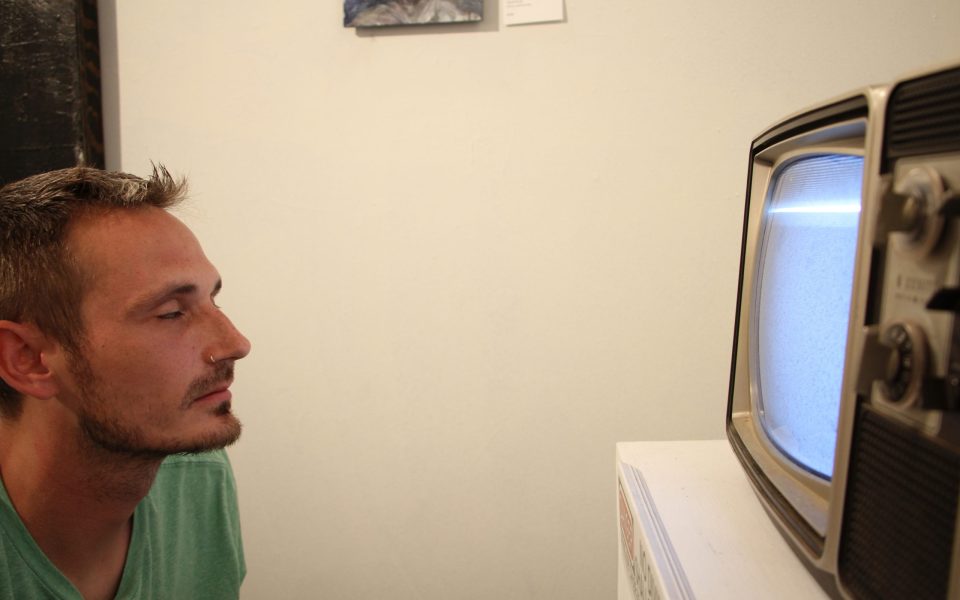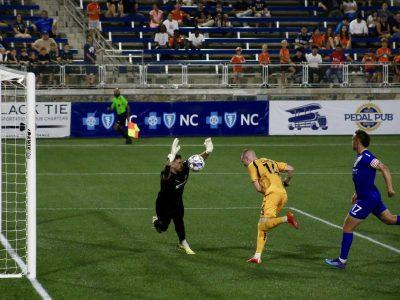by Daniel Wirtheim
The subjects of David Shaw’s work are his own youthful memories from a time when Winston-Salem was still fresh to him and he didn’t have to worry about paying rent. As he moves along Third Street, his right hand is wrapped in gauze, the result of dropping a steaming tray of lard-soaked chicken out of an oven. He walks purposefully, not talking unless necessary. A ragged looking man approaches him, asks for a cigarette and Shaw asks him for a quarter.
Just a few years ago, Shaw was able to support himself with his interior-design business. But now, since it tanked, he got a job at BB&T Park and continues to paint in his free time. He’s currently painting murals with the non-profit organization, East Winston ARTUP.
“The layers are what make up our lives,” Shaw said in reference to his painting style, “the strands that make us humans, always experimenting, building on top of that the way we build upon our lives.”
His painting style is abstract, to say the very least. Like a musician bends a note or a DJ hits a turntable, David Shaw’s brushstrokes are repetitive, relying on a visceral feel for the canvas. He repeats the lines so much that his paintings are thick with layers, and the meaning fairly indecipherable.
“George,” a painting inspired by the memory of a photograph of Shaw’s grandfather is an eye-catching cluster of lines. A figure poses but the face is a mess of white streaks. Hair, a nose or eyes are completely unrecognizable. “George” is both creepy and captivating.
Like a lot of Shaw’s work, appreciating “George” relies somewhat on understanding the process.
“George” is Shaw’s response to a photograph of his grandfather that was kept in his childhood home. “It’s like a muscle memory almost, the shadow of that memory was burned in my mind,” Shaw said. “I like to leave things amorphous.”

©
Most of Shaw’s paintings show a similar process of meticulous abstraction from a memory. An occasional figure surfaces but Shaw’s work for the most part is a detachment from reality and into the world of layered dreams and hyperactivity.
“40th Avenue” is a good standard for Shaw’s landscapes, which are mostly one or two colors fragmented with stripes of varying shades and tones. Occasionally, price stickers or other artifacts of consumer culture to balance the painting.
Small shootouts to Shaw’s friend, Mike, who died of a random food allergen, are dispersed throughout his paintings. It gives Shaw’s work a homegrown feel, a very human streak in an otherwise abstract collection.
“I remember being a kid and going to Reynolda House and seeing this one huge piece by Nam June Paik,” Shaw said. “That for some reason was captivating to me as a kid, because I had never seen conceptual art before.”
Like Paik, who pioneered video art, Shaw finds inspiration in television. In his recent exhibition at Delurk Gallery, a screen that played overlapping layers of a Korean commercial and a girl eating noodles was shown in a shelf that he designed.
“I like things that are disruptive,” Shaw said. “To do anything abstract you have to know the rules before you can totally smash them into pieces and rearrange them, or otherwise you’re just a moron.”
At a recent exhibit Shaw sold nothing. The paintings are just sitting in his apartment that was recently flooded. The seasonal employment has been taking a toll on his social life and he still doesn’t like to talk about his old business.
“It’s like you have this baby, it starts growing and it gets run over by a f***ing garbage truck,” Shaw said. “But it helped me realize that I don’t want to spend my whole life trying to win the lottery or climb a corporate ladder. I’m a painter; I paint.”
This article appeared in print with the headline “Layers of paint.”
Join the First Amendment Society, a membership that goes directly to funding TCB‘s newsroom.
We believe that reporting can save the world.
The TCB First Amendment Society recognizes the vital role of a free, unfettered press with a bundling of local experiences designed to build community, and unique engagements with our newsroom that will help you understand, and shape, local journalism’s critical role in uplifting the people in our cities.
All revenue goes directly into the newsroom as reporters’ salaries and freelance commissions.





Leave a Reply